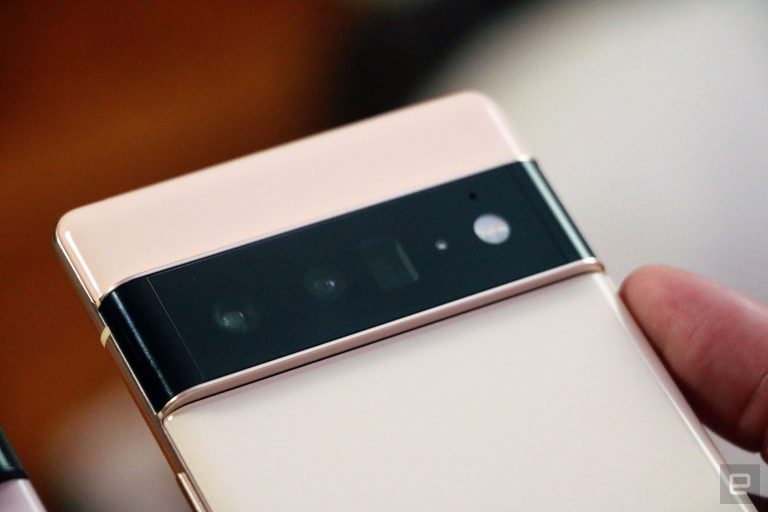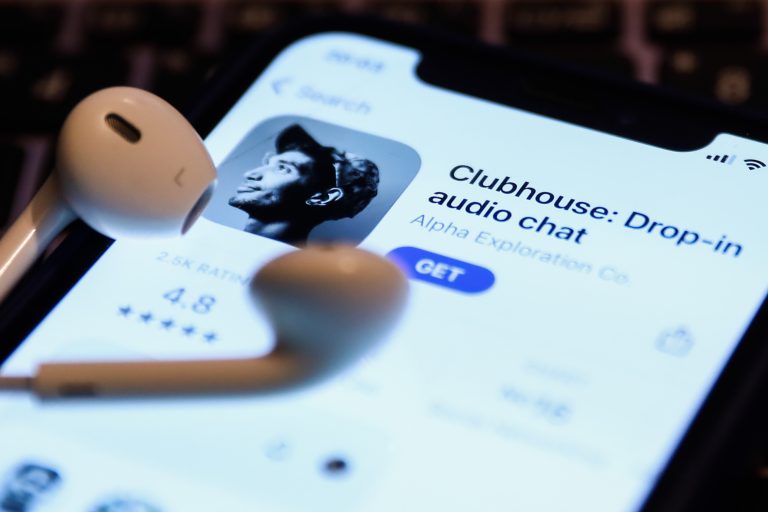Apple AirPods (2021) review | Engadget
Image Credit: Billy Steele/Engadget
Sound quality
I don’t want to mince words here: the new AirPods sound so much better than the previous two versions. Like almost night and day better. Apple didn’t make any significant changes to sound quality from the first model to the 2019 version. But for gen three, Apple paired a custom driver with a high-dynamic-range amplifier to improve the audio chops. The company says that the duo work together to produce “rich consistent bass” and “crisp, clean” highs. From the moment I fired up the first song, this was all immediately evident. I don’t think I’ve ever audibly said “woah” with the first note from a guitar on any review unit, but given how average older AirPods sound, it was involuntary this time.
Overall, the sound is bigger and more immersive. It’s open and airy, instead of being compressed and downright boring like older AirPods. While greatly improved, the sound quality doesn’t match the absolute best I’ve tested: Sony’s WF-1000XM4, Master & Dynamic’s MW08 and Sennheiser’s Momentum True Wireless 2. However, the new AirPods do sound better than the Galaxy Buds 2 and are comparable to Jabra’s Elite 75t — both of which offer active noise cancellation and are more in line with Apple’s latest in terms of price.
Even without spatial audio tracks, music feels dimensional with vocals, instruments and other sounds standing on their own. The performance is consistent across the bluegrass picking of Nickel Creek to the bluesy folk rock of Jason Isbell and the grungy metal of Every Time I Die. Sure, part of this is due to the new driver/amp combo, as the crisp treble and constant, but not overpowering, bass help create these soundscapes. Another reason is the new shape of the earbud that better directs sound into your ears.
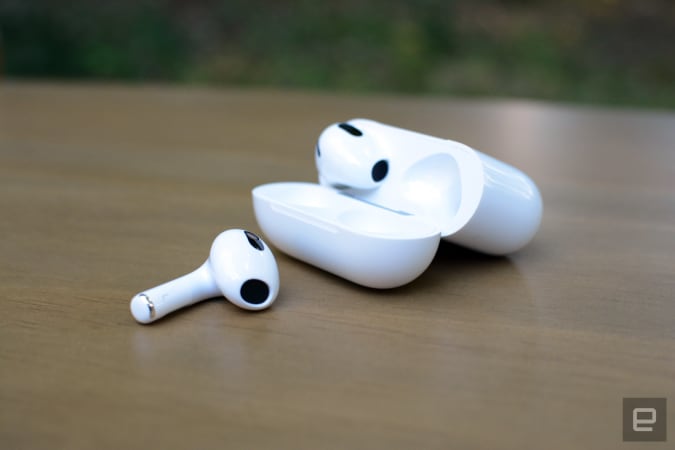
Billy Steele/Engadget
The third aspect is Adaptive EQ, a feature Apple first introduced on the AirPods Max. Using computational audio, the company’s H1 chip and the inward-facing mic, AirPods tune the music for how the earbuds fit in your ear. Adaptive EQ constantly monitors sound and adapts low- and mid-range frequencies in real time. All of these updates make the new AirPods something I actually wanted to listen to music with, rather than something that was just more convenient that other earbuds.
The new AirPods also support Apple’s spatial audio. This means you can listen to tracks that are available in Dolby Atmos on Apple Music with no issue. I can respect that spatial audio as a concept is divisive: some people like it while others don’t. I don’t care for it with the AirPods Max, but I think it sounds better with these new AirPods. Dolby Atmos seemed a bit too spacious at times with Apple over-ear headphones (Kacey Musgraves’ Golden Hour is a prime example), but that’s not the case with the supported earbuds. I’m not sure it will sway folks who don’t care for spatial audio currently, but that’s why you have the ability to disable it entirely.
Like the AirPods Pro, spatial audio here is also available with dynamic head tracking, which changes the position of the audio in your earbuds when you turn your head. iOS will allow you to switch between fixed spatial audio and dynamic head tracking via the volume slider in Control Center. There’s also a third option to disable the immersive sound entirely from here. I think head tracking has some benefits when you’re watching a movie or TV show, but when you’re listening to music, it’s not so great. Especially when you momentarily walk away from your computer or phone. For that reason, easy access to these controls is a great thing.
What you won’t find here is active noise cancellation (ANC) or a transparency mode. Apple has reserved both for the pricier AirPods Pro, and there’s a key reason why. The third-gen AirPods allow some outside sound in by design as they don’t completely seal off your ear canal. This would make an ANC setup difficult and means the AirPods are “transparent” by default. Much like the design, if you consider the features of the new AirPods as the middle ground between the base model and the Pro version, a lot of these decisions make sense.
Call quality
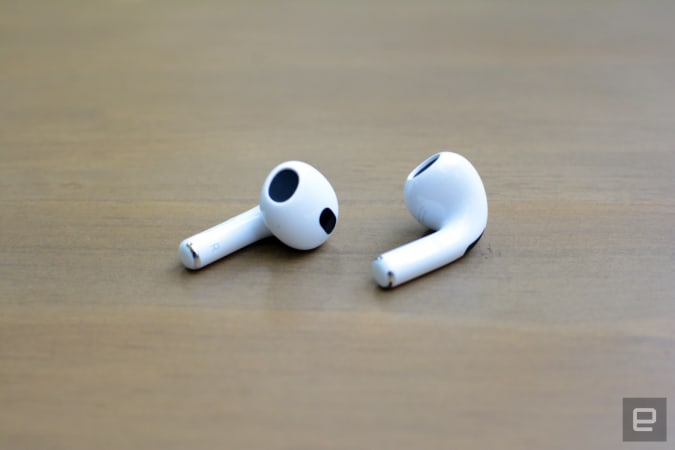
Billy Steele/Engadget
As ever, Apple is hyping the voice quality on its latest AirPods. The company says new acoustic mesh covers for inset microphones help reduce wind noise. These earbuds also support the AAC-ELD codec, which Apple says enables “full-HD voice quality” to keep you sounding crisp and clear on FaceTime calls. What’s more, the AirPods support spatial audio in Group FaceTime calls to further simulate the feeling of being in the same room. Basically, the sound from the person who is talking comes from the direction they’re positioned on your screen. It’s not like speaking IRL, but it is an improvement. It makes calls more immersive, plus you can get an even better sense of directional audio when your device is in landscape mode.
Indeed, FaceTime calls are crisp and clear with the new AirPods. Phone calls are improved as well but not to the same degree. Voice quality is here better than most earbuds I’ve tested, but not by a ton. True to Apple’s claims, these AirPods do a decent job blocking background noise and focusing on your voice. It’s great when you’re talking, but the clamor resumes when you’re not speaking. Depending on how loud the noise is, it might be distracting for the person on the other end. There are improvements in regards to voice, but you’ll notice them most in FaceTime.
Battery life
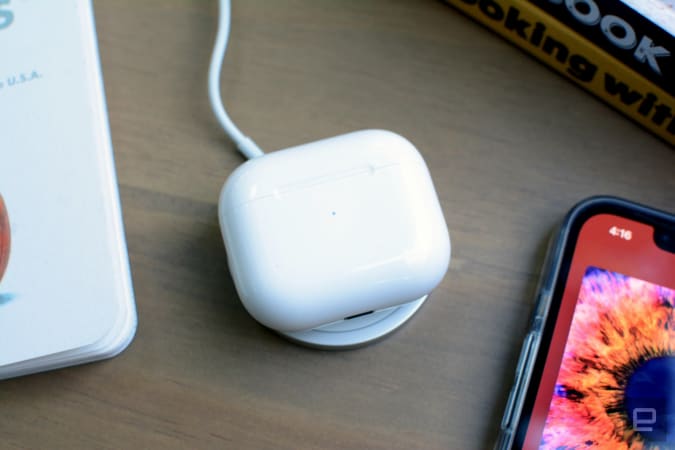
Billy Steele/Engadget
To accompany the redesign, Apple also increased battery life on the new AirPods. The company says you can expect up to six hours on the earbuds themselves and up to 30 hours total when you factor in the case. I actually managed just over seven hours during my tests, and that’s with fixed spatial audio on (but without dynamic head tracking). Since the second-gen version was rated at five hours, over seven is a significant upgrade for those who use headphones throughout their work day.
If you find yourself in a pinch, the new AirPods have the same quick-charge feature as the AirPods Pro: five minutes in the case gives you about an hour of use. Where the original AirPods Pro case supported wireless charging, now both it and the case for AirPods is equipped with MagSafe. The MagSafe case still works with Qi-certified pads, but Apple will sell you a magnetic charger for a better experience. Just remember: the second-gen model that Apple kept around for $129 doesn’t support wireless charging at all.
The competition

Billy Steele/Engadget
There’s never been a doubt that AirPods are built for iPhone, iPad and Mac. Nearly every feature is meant to enhance or extend the tools available on those devices, including giving you the ability to access Siri and other things without reaching for an iPhone. By adding the third-gen AirPods in the middle of its lineup, Apple has replaced the 2019 model with a wireless charging case. That leaves its roster with the original design (second-generation) at $129, this model at $179 and the AirPods Pro at $249. The company now has a trio of options akin to what Samsung has offered for a while now: a range of choices with varied options and prices.
At this point, the only options that come close to the deep iOS integration AirPods offer are products like the Powerbeats Pro. A few models in the Beats lineup offer handy features like fast pairing and hands-free Siri since they’re powered by Apple’s H1 chip. The more affordable Studio Buds ($150) don’t have that component, but they still offer the ability to wake the assistant without reaching for your phone. The Beats Fit Pro leaked earlier this month and initial reports indicate they too will carry Apple’s powerful earbud tech, but we don’t know about price just yet. There are plenty of options that sound great and have handy features in their own right, but nothing without the H1 chip syncs as well with Apple’s devices.
If you want active noise cancellation or ambient sound in some tiny earbuds, the Galaxy Buds 2 are a solid bet. Unfortunately, Samsung scaled back its iOS integration a few models ago, but these still work well with iPhone and the like. If ANC, spatial audio or hands-free Siri aren’t things you need, Jabra’s Elite 3 earbuds are the best value right now. They’re tiny and comfy, but the sound is impressive and the battery life is good. Plus, they’re only $80.
Wrap-up
No modest update this time around. Apple totally overhauled AirPods for the third-generation version with the biggest changes coming in the design and audio quality. The company also expanded availability of key features like spatial audio and Adaptive EQ to a more affordable set of earbuds while keeping all of the convenience of AirPods intact. These earbuds still aren’t for everyone, but what they offer the Apple faithful can’t be found elsewhere and the company will do well to keep it that way.
All products recommended by Engadget are selected by our editorial team, independent of our parent company. Some of our stories include affiliate links. If you buy something through one of these links, we may earn an affiliate commission.



